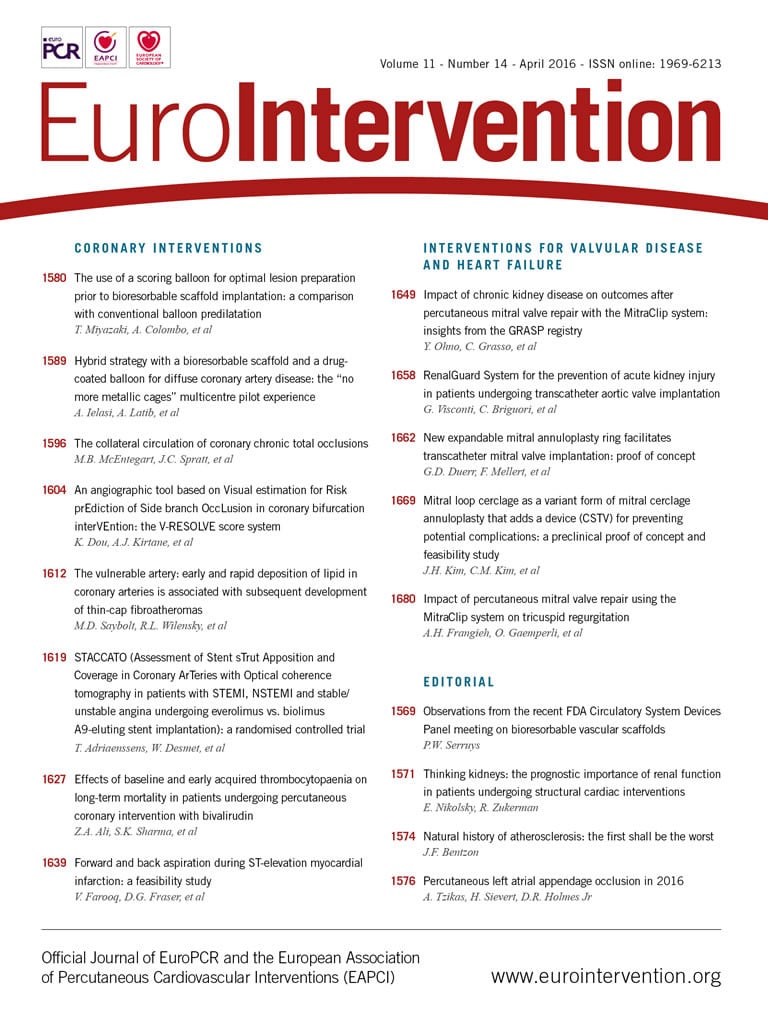
Renal function is a crucial determinant of prognosis in patients with cardiovascular diseases. Newly diagnosed acute kidney injury (AKI) or deterioration of renal function in patients with pre-existing chronic kidney disease (CKD) is strongly linked to decreased survival in patients treated with percutaneous coronary interventions1. In this issue of the Journal, two studies further expand the existing evidence on the prognostic importance of renal function in patients undergoing structural cardiac interventions2,3.
In the study by Ohno et al, summarising the experience from the prospective Getting Reduction of Mitral Insufficiency by Percutaneous Clip Implantation (GRASP) registry, more than 50% of the patients with symptoms of heart failure and moderate to severe mitral regurgitation (MR) had baseline CKD2. This is in line with multiple studies showing that CKD is very common in patients with advanced stages of heart failure4. In fact, CKD is being found in every third patient with New York Heart Association (NYHA) Class III and in at least 40% of the patients in NYHA Class IV5. Mitral regurgitation is an integral part of the vicious cycle: it leads to deterioration of congestive heart failure, which, in turn, causes decline in renal function. Development or progression of CKD in patients with advanced heart failure results from several mechanisms, mainly from the altered haemodynamic state (decreased cardiac output and elevation of intra-abdominal and central venous pressures) as well as from the enhanced neurohormonal and inflammatory activation. This important interaction between failing heart and CKD represents a basis for the widespread concept of the cardiorenal syndrome6.
Correction of MR using a MitraClip® procedure (Abbott Vascular, Abbott Park, IL, USA) was found to be a safe and effective therapeutic option for selected patients with significant MR7. However, whether a decrease in MR severity using MitraClip improves the clinical outcomes of patients with pre-existing CKD is not known. In the GRASP registry, despite the similarly high rates of procedural success resulting in significant reduction in MR severity along with improvement of functional status of the patients at early (30-day) follow-up, the one-year results were remarkably worse in patients with CKD2: patients with CKD had significantly higher rates of mortality, MR recurrence and rehospitalisation. Likewise, in the general population with heart failure, CKD was a strong independent predictor of poor clinical outcome (a composite of mortality, surgery for mitral valve dysfunction or MR grade ≥3). At one-year follow-up, MR grade ≥3 was related to the degree of mitral leaflet calcification in both univariate and multivariable analyses. The exact reason for such an association is not clear. Given similarly high rates of procedural success regardless of the presence or absence of baseline CKD in the registry population, excessive calcification of the mitral valvular apparatus probably represents a marker of more advanced inflammatory condition and atherosclerosis burden. Previously, a significant association was found between mitral annular calcification and both all-cause and cardiovascular mortality8.
The results of the study evoke several questions. First, should patients with moderate/severe MR and advanced stages of CKD be treated with percutaneous techniques? More prospective studies are needed to define further the profile of the patients who may not benefit from the procedure. Second, would correction of MR at the earlier stage when renal function is still preserved or only mildly impaired provide better long-term outcomes? Third, is a decline in renal function reversible in patients with successful correction of MR? There is a signal of such a positive relationship from the pooled analysis of 854 patients from the randomised Endovascular Valve Edge-to-Edge Repair Study (EVEREST) II trial, the EVEREST II high-risk registry, and the prospective, multicentre Real World Expanded Multicenter Study of the MitraClip® System (REALISM) study, in which the repair was associated with a small improvement in estimated glomerular filtration rate in patients with moderate or severe CKD at baseline9.
Development of AKI is one of the well-known complications in patients undergoing transcatheter aortic valve implantation (TAVI). The combination of old age and several comorbidities (diabetes, hypertension, anaemia, and pre-existing CKD) with certain periprocedural factors (periods of hypotension, manipulation with relatively large catheters in the aorta and administration of iodinated contrast media) increases remarkably the risk of AKI in these patients. At present, no pharmacological agents have been shown to prevent further deterioration of renal function in patients with baseline CKD. Generous intravenous hydration remains the most reliable tool for kidney protection. There is a growing body of evidence that the use of the RenalGuard® system (PLC Medical Systems, Inc., Milford, MA, USA), which allows the achievement of a high urine output while maintaining euvolaemia, has a protective effect on kidneys in patients with various degrees of CKD undergoing coronary interventions or TAVI (Table 1). In the recently published randomised PROphylactic effecT of furosEmide-induCed diuresis with matched isotonic intravenous hydraTion in Transcatheter Aortic Valve Implantation (PROTECT-TAVI) trial in a total of 112 patients with severe aortic stenosis and various functional status of the kidney (mean estimated glomerular filtration rate [eGFR]: 50 mg/dL; eGFR 30-60 mg/dL: 39.3% of the patients, and eGFR ≤30 mg/dL: 7.1%), treated with TAVI, the use of RenalGuard was associated with significantly lower rates of AKI compared to control (5.4% vs. 25.0%, p=0.01)10.
In this issue of the Journal, a prospective non-randomised pilot study by Visconti et al3 focuses on the importance of renal function protection in TAVI patients who have a particularly high risk of developing AKI (eGFR ≤30 mL/min/1.73 m2 or predicted risk for AKI ≥50%). The results of this small study are encouraging, with significantly lower rates of AKI in patients who received intensive hydration with normal saline matched to urinary output using the RenalGuard system compared to patients hydrated with sodium bicarbonate (4.5% vs. 38.5%, p=0.005). Notably, while one may expect exacerbation of heart failure in patients with severe aortic stenosis receiving intensive periprocedural hydration, the symptoms of heart failure were not more frequent in the RenalGuard group compared with control. Actually, hydration with RenalGuard, whose protocol is based on the minimal volume expansion, may be advantageous over standard, poorly controlled regimens of fluid administration in patients with severe aortic stenosis who are at risk of heart failure exacerbation. The study also provides an analysis of the incidence of periprocedural hypotension and its duration at different periprocedural stages. Two thirds of the patients experienced intraprocedural hypotension with a mean duration of 7.5 min in the control group and 6 min in the RenalGuard group; hypotension continued post-procedure for an average duration of 90 min in each group. Development of hypotension along with a higher volume of contrast medium independently predicted renal function deterioration. The relatively high volumes of contrast media required during the procedure are worth noting (mean: 162 mL and 188 mL in the RenalGuard and control groups, respectively). In-hospital dialysis was required in two patients in the control group and in none of the patients in the RenalGuard group. Freedom from dialysis is no doubt one of the most important outcomes after survival.
One should remember that, even though only a minority of patients are dependent on dialysis at hospital discharge, patients with AKI are at increased risk for end-stage renal disease at later follow-up. According to epidemiologic studies, AKI accelerates initiation of dialysis in the CKD population. In one study on Medicare beneficiaries from the USA, elderly patients with CKD who developed AKI were 55 times more likely to develop end-stage renal disease at two-year follow-up than patients with preserved renal function and no episodes of AKI11. Taking into consideration all these data, AKI should not be viewed as a reversible procedural complication or short-term condition. Improvement of long-term outcomes of the complex population undergoing structural heart interventions is impossible without reliable ways to protect the kidneys and to slow the progression of CKD. Undoubtedly, close surveillance by nephrologists and cardiologists is imperative post procedure in order to address appropriately the pharmacological therapy to minimise the potential nephrotoxic effects.
Conflict of interest statement
The authors have no conflicts of interest to declare.

